Cruising Resources: Orcas and Yachts
UPDATE 2025
Orcas around the Atlantic Iberian Peninsula
Since 2020 there has been a pattern of behaviour within a population of orcas that feeds on and follows the migration of tuna exiting the Mediterranean from the Strait of Gibraltar and heading West and North around the Iberian Peninsula over a period of several months.
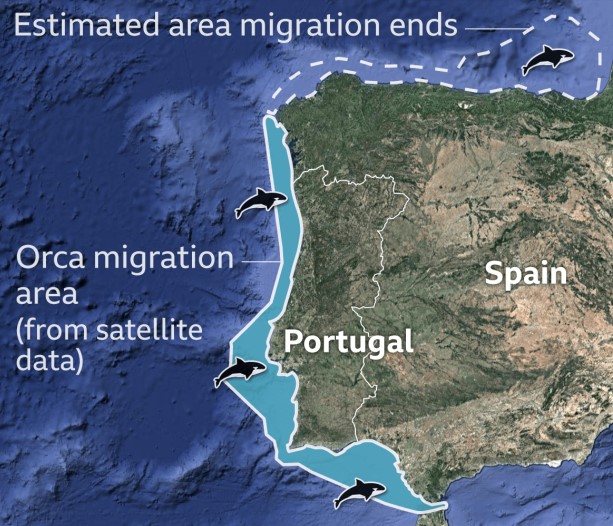
This behaviour has seen juvenile orcas interact with vessels (mostly sailboats) that are transiting this coastline, in many instances causing damage to rudders. Orca encounters are now a common risk for yachts making passage in the waters off the western Iberian peninsula.
Many yachts don’t come across Orcas and a great number sight the whales, but have an incident-free encounter. However there are instances where interactions have appeared “threatening”, with a growing number of yachts suffering severe rudder damage.
Up until July 2022, interactions were limited to just damage; the orcas’ ‘playing’ with rudders of sailing boats essentially left them stranded, but otherwise intact. The worst that happened was a wait for rescue, and then an expensive repair bill.
But that changed in July 2022 when a family’s boat sank after a late-night ‘interaction’ off Sines in the south of Portugal, followed by a second sinking off Viana do Castelo in the north of Portugal at the start of November 2022. Six yachts have been sunk to date, with the most recent on July 2024 in the Straits of Gibraltar.
The reason for this recent and repetitive behaviour towards small vessels is still not fully understood, however, after several years of increased interactions between orca and yachts, scientists now have some theories as why this is happening. Interesting articles with alternative views from scientists include:
- When Orcas Speak (Sarat Colling – November 2023)
- Why are orcas suddently ramming boats? (BBC – June 2023)
- Is playing with yachts just “in vogue” for orcas? (NPR – August 2022)
- Orcas have sunk 3 boats in Europe and appear to be teaching others to do the same. But why? (Live Science – May 2023)
- Orcas Sailboat Attacks: Aveiro Scientist Offers Explanation (Portugal Resident – May 2023)
- Is the Whale World Rising Up? (Guardian – May 2023)
Tools for finding the Atlantic Orcas
If you are planning a passage around the Iberian peninsula, do your research first and identify where you can get the latest location information on encounters and orca sightings. It can be confusing as more and more initiatives to track and discuss orcas in this area develop, all wanting data from yacht skippers and all offering advice etc. Below we outline the main organisations that you should consult and report to if an interaction takes place.
- Grupo de Trabajo Orca Atlántica [GTOA] have a database with more than 1000 orca sightings in this region since 2020. They were the first organisation to start collecting data about the orcas and yachts and continue with their efforts. They have an active mobile app and are definitely the first place to report an interaction or find out the latest activities. Find out more at https://www.orcaiberica.org/.
- In 2022 The Cruising Association established a collaborative agreement with GTOA and began asking yachts to report sightings and interactions. Go to https://www.theca.org.uk/orcas/interaction-report-form. Their advice and conclusions can be found at www.theca.org.uk/orcas/. This project is on-going and relies on feedback from as many skippers as possible making this passage, whether they encounter orcas or not. There is a great deal of detail here and very interesting reading. A map shows you a history of incidents with all the feedback reported, there is a section on extracts from these reports as comments filed under what measures were taken by skippers when encountering orcas, plus a recommended safety protocol and current guidance.
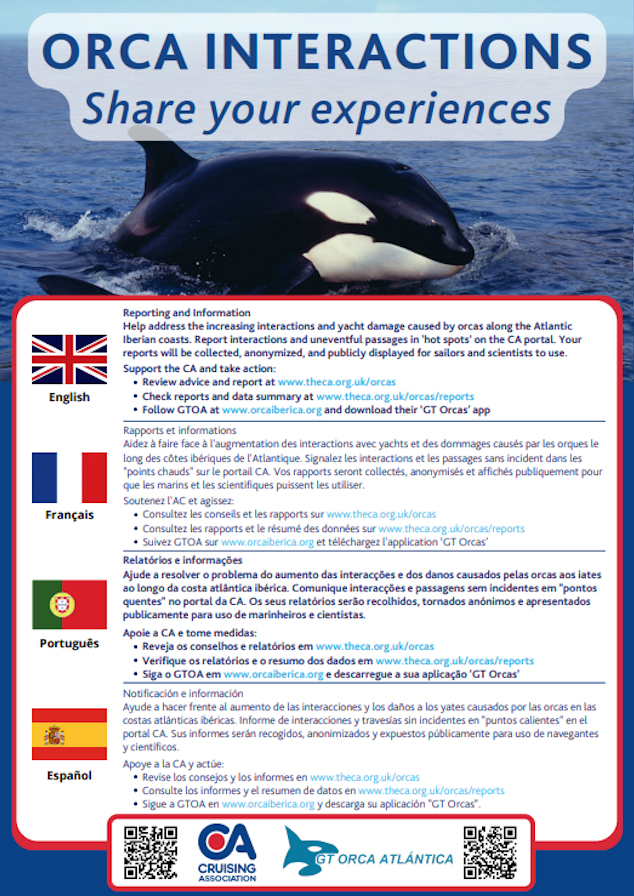
- In May 2023, the CA updated its ‘orca information and reporting’ portal reflecting the research and analysis the CA had conducted since June 2022. The CA’s killer whale project team has analized over 300 reports of interaction and passage without incident received in 2022 and some patterns have emerged which are shared on the portal. All CA interaction and sighting records are listed on the GTOA GT Orcas app.
- Orcas.pt [https://www.orcas.pt/] is a community-driven group that report and discuss. They have two Telegram conversation groups for yachts transiting this coast. One of the groups is for sharing the location of orcas only, and the other is a discussion group to exchange experiences and mitigation actions to avoid an incident. There are over 1000 members and the groups are very active. Go to Orcas @ Portugal & Spain to sign up. They also have a Facebook Page and a You Tube Channel with interesting discussions about the Iberian orcas. Again, Orcas.pt does not dedicate any resources to monitoring orcas (unlike GTOA) and do not collaborate with GTOA.
- In January 2023, the autonomous authority of Galicia launched an application called Orcinus which shows the previous month’s interaction and sighting data (which then disappears). Find out more at this news report. Note, that Orcinus does not dedicate any resources to monitoring orcas (unlike GTOA) and do not collaborate with GTOA.
- Circe [https://circe.info/orcinus/] monitor the population of orca in the Gulf of Cadiz.
- There is alot of useful information and feedback on the Orca attack Facebook group: Orca Attack Reports.
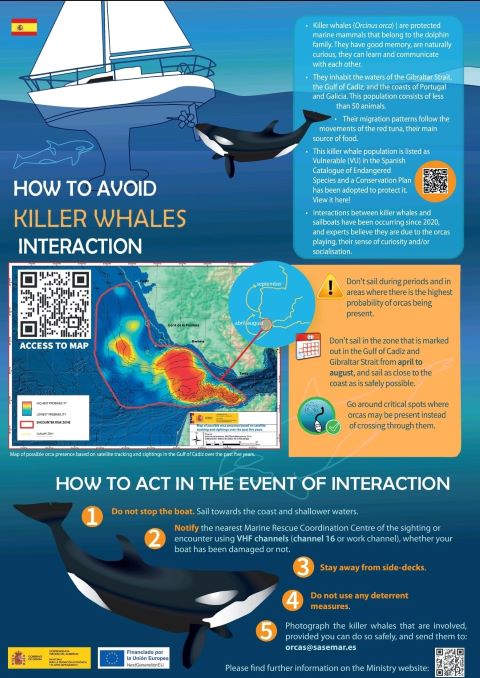
How to Navigate “Orca Alley”
If preparing for a transit around/along the Iberian Peninsula where orca are active, use these guidelines published by Noonsite in collaboration with the CA and learn how you can use your experience to help those following in your wake.
- Read Part 1: Passage Planning Tips (January 2024)
- Read part 2: FAQs Prior to Departure (February 2024)
- Read part 3: What to do at sea should you encounter orcas (March 2024)
- Read Part 4. Analysis of orca locations (April 2024)
Other useful articles/webinars/links to help prepare include:
- How to Avoid Killer Whales Interaction Poster (above) – produced by the Spanish Government.
- The Spanish Maritime Transport webpage has orca recommendations
- Orcas.pt – Talking about orcas with Renaud de Stephanis of Circe (March 2024)
- Orca Encounters on boats: What you need to know (Practical Boat Owner January 2024)
- Dealing with Orca “Attacks” and How to Navigate “Orca Alley” (Yachting Monthly September 2023)
- Useful recording of CA webinar Orca and Yachts: Fact, Fiction and Fear (May 2023)
A growing number of yachting organisations are publishing advice for yachts, alongside recommendations from orca working groups. This can all be found in the useful resources on this page, as well as news of reported encounters with yachts and orca-related reports.
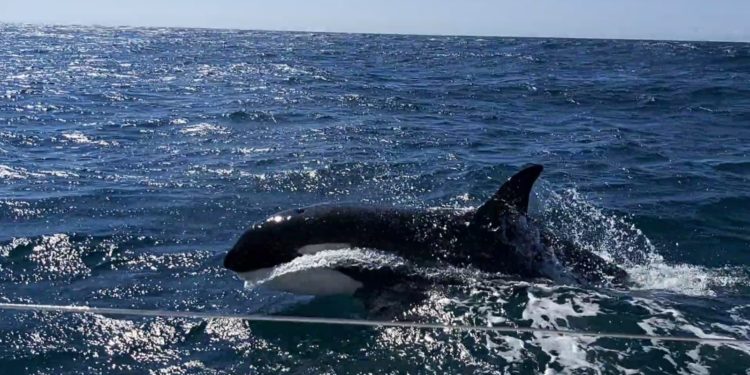
Avoiding the Orcas
The Cruising Association note that the majority of interactions have occurred in a water depth greater than 40 metres and the CA data at www.theca.org.uk/orcas/reports (comparative data tab) highlights the increased risk posed by traveling in deeper water. Their advice to avoid interactions is to stay less than two miles off shore and navigate in less than 20 metres of water.
That said, orca are now venturing to within the 20m depth contour and interactions and damage have been reported during late Spring/Summer 2025.
In the southern Spain (Barbate) area, where incidents occur frequently, it is possible to pass through the area in, or near to, the 20m depth contour. However wind, sea state and tides need to be considered with regard to the possibility of being disabled near to shore or shallows and the huge tuna nets need to be avoided (it is understood to be possible to pass inside the net at the Barbate harbour entrance.)
Orcas.pt recommend the safest route towards Gibraltar is going to Cadiz and following the coast along the 20-meter depth contour until Gibraltar.
The Spanish Government (see poster previously) recommend avoiding sailing in this area from April to August if possible.
It’s also useful to review the CA Orca Project collated library of skippers’ comments on deterrent measures – www.theca.org.uk/orcas/interaction-deterrent-library
In Spain and Portugal, current legislation does not allow the use of acoustic devices to deter orcas. Since 2022 GTOA have been collaborating with the working group launched by the Portuguese government in which an acoustic proposal proposed by GenusWave has been selected, which is being prepared for tests at sea, experimentally but not on yachts. It is hoped this may be available for the 2024 season. See more information here.
Orca Reports:
See “Discover More” below and related news for latest reports.
June 2025:
See OCC member report of an orca interaction and damage on 24th June off Cabo Espichel (S of Lisbon)
May 2025:
Yachts staying within the 20m contour off Barbate – south of the Gulf – have been intercepted by orca and had rudders damaged in recent weeks.
September 2024:
Eight orca reported off Ria de Arousa Monday 2nd September.
02.09.2024: Departing Ria de Arousa heading south, 1.5NM offshore, instant hit by orca, one third of rudder gone. Hanse 345, under sail, no autopilot on, spade rudder, depth of water 38m (from Orca Attack Reports on Facebook).
August 2024:
July 2024:
- We sailed through Orca Alley: One Family’s Journey (article for Outside Online)
- 12m yacht broken rudder SW of Brest, NW France
- Straits of Gibraltar: Vessels sinks after orca interaction
May 2024: First yacht sunk in 2024 (15m sailboat), May 12th, 14 miles from Cape Spartel at the southern entrance to the Strait of Gibraltar.
April 2024: On 11 April, first interaction with orca this year off Galicia (Finisterre – Malpica) resulting in a broken rudder. GTOA predict orca are traveling south.
March 2024: Orcas active off Figueira da Foz, Portugal – catamaran suffered rudder damage (from Orca Attack Reports Facebook Group).
November 2023: Two yachts sunk in Straits of Gibraltar.
From Orca Iberica GTOA, 8 November, 2023: Based on the 10 records of interaction and sightings of orcas in the Strait of Gibraltar, from October 25 to November 7 (13 days), we have established a map of occupation of the environment and risk of passage. At this moment, several groups of orcas are entering the Strait of Gibraltar from the west (orange arrow I) and from the southwest (orange arrow II), parallel to the African coast. The establishment of these groups of orcas in this area delimits three distribution areas:
- A: central establishment area, west of the maritime traffic device-DTM.
- B: movement zone, between this area and the east of Tarifa.
- C: expansion areas, to the west, towards the south of Trafalgar, corresponding to the western entrance road, and to the east to Gibraltar.
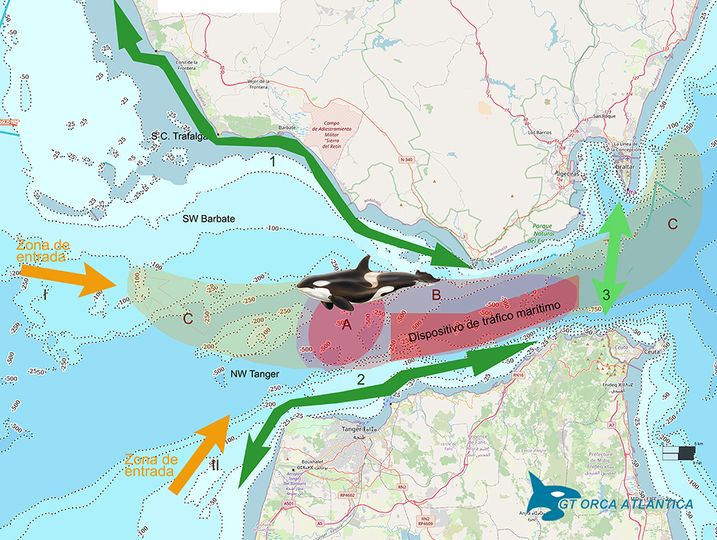
August 2023
- In a change of behaviour, orcas have been sighted inside the Rias Baixas for the first time in many years – Ria de Arousa and Ria de Vigo. A French yacht was intercepted by orcas inbetween the islands of Salvora and Ons (at the mouth of Ria de Arousa) in 60m depths on 19 August, 2023.
- Orcas interacting with yachts off Northern Spain in the Gulf of Bizkaia off the Basque coast. See news item here. The first incident was 20 miles north of Zumaia on Saturday 12 August, 2023, and the second 18 miles north of Ondarroa in the early hours of Sunday morning (probably the same group).
July 2023
- Orcas moving into the Mediterranean, latest sighting off Marbella. See https://www.orcaiberica.org/
June 2023
- Volvo Ocean Race encounters orcas off Gibraltar (Telegraph – good underwater video of orca behaviour)
- Orca ‘rams yacht’ off Shetland as close encounters spread to North Sea (Yachting Monthly)
May 2023
- Orcas have sunk 3 boats in Europe and appear to be teaching others to do the same. But why?. (Live Science)
- Cruising yachts are reporting daily of increased orca activity to the south of Barbate (in the region of position 36°05’11.80″ N, 06° 00’20.52″ W). On 4 May a yacht was sunk in that area.
April 2023
- A Fountain Pajot New Isla 40 catamaran with black underwater paint reported an encounter with four Orcas on April 12 at 36deg. 03.35‘N 006 deg. 11,3‘W that lasted about seven minutes. The vessel continued to Gibraltar without any other incidents and after a diving inspection found two cracks in the rudder.
Iberian Orca Reference:
- https://circe.info/ – (Conservation, Information and Study on Cetaceans)
- Share the CA’s Orca Reporting Poster with fellow sailors.
- We sailed through Orca Alley: One Family’s Journey (article for Outside Online July 2024)
- Dealing with Orca “Attacks” and How to Navigate “Orca Alley” (Yachting Monthly September 2023)
- Exellent article for Yachting Monthly by a skipper attacked by orcas off Peniche/Cascais, Portugal (August 2023)
- The Cruising Assocation webinar “Orca and Yachts: Facts, Fiction and Fear” (May 2023) – Watch it here.
- Black Antifoul suspected cause of Orca attacks
- CA Orca Project Update – May 2023
- Orca interactions with boats expected to stop (Yachting World December 2022)
- LaVozdeGalica.es (September 2022): Four yachts (France, England, Netherlands and Norway) had to request a tow approx. 6 miles NW of Malpica, off the coast of Carballo, A Coruna. All suffered rudder damage.
See News below for more articles.



